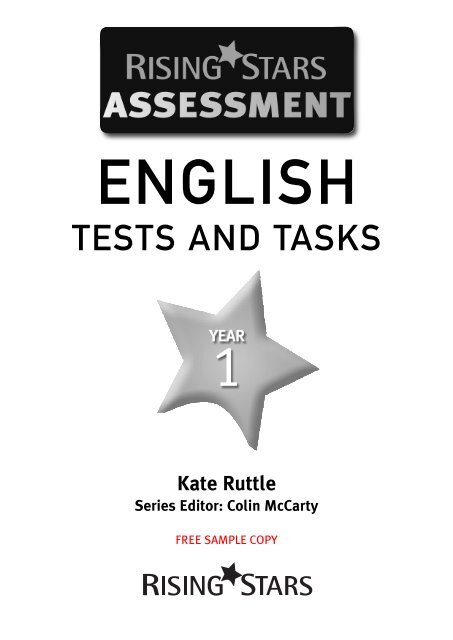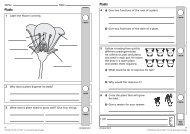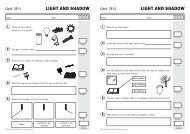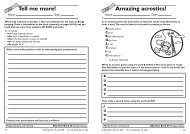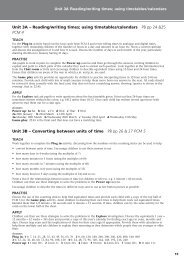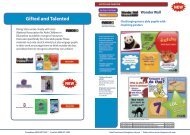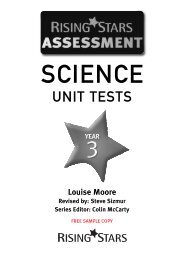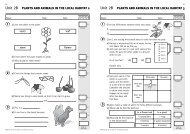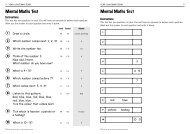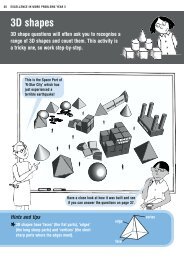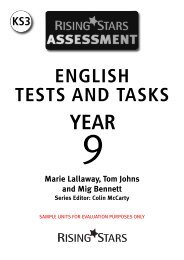1 - Rising Stars
1 - Rising Stars
1 - Rising Stars
- No tags were found...
Create successful ePaper yourself
Turn your PDF publications into a flip-book with our unique Google optimized e-Paper software.
ENGLISHTESTS AND TASKSKate RuttleSeries Editor: Colin McCartyFREE SAMPLE COPY
Quick start guide to <strong>Rising</strong> <strong>Stars</strong> AssessmentStep 1 Introduce the testsExplain to the class that they will take an English test once each term.This will give them the opportunity to show what they know and cando. The tests are designed to give them an opportunity to show theirprogress in reading and writing, and results can be used to record andmonitor progress throughout the year.At the end of each term, photocopy the test and give it to the class tocomplete.You may also project the test onto a whiteboard to support the wholeclass or a group in the reading tests or writing tests. You may choose torefer to the words on the whiteboard and read them aloud so thatpupils can follow them and write their answers on their papersindividually.More information about using the tests is given on pages 5–7.Step 2 Mark the testTests and tasks can be marked by the teacher, or by the pupil. Pupilsmay assess their own work or swap tests and mark another pupil’s test.Use the mark scheme and your own professional judgement to awardmarks. Do not award half marks.We suggest you annotate the mark grid for the writing task with a tickto indicate the bullet points for which you are awarding credit. Circle orwrite the mark you are giving.The mark schemes for reading include information about the level ofeach mark and the assessment focus that is targeted through individualquestions.Word Reading Test 1Mark schemes for reading testsAutumn termWord Reading Test 1AF Mk Lvl1. points to picture/writing 1 1 P82. sun sock 1 1 P83. mouse man 1 1 P84. cat hat 1 1 P85. dog 1 1 1c6. hen 1 1 1c7. pin 1 1 1c8. in 1 1 1b9. like 1 1 1b10. the 1 1 1bSpring termWord Reading Test 2AF Mk Lvl1. s 1 1 P82. sh 1 1 P83. hat 1 1 1c4. bed 1 1 1c5. tap 1 1 1b6. my 1 1 1b7. you 1 1 1b8. going 1 1 1a9. like 1 1 1a10. grab 1 1 1aSummer term26Name: Class: Date: ☺☹AF11 Point to a picture on this page. Point to some writing.12 Ring two picturesAF1that begin with the2same sound.AF13 Ring two pictures3that begin with thesound m.AF14 Ring two pictures that rhyme.4Look at each picture. Ring the right word for the name.5 6 7tinhatpinFinish the sentences. Ring the words to fill the gaps.89It isI10 This is8Word Reading Test 3sundogAF Mk Lvl1. m 1 1 P82. bus 1 1 1c3. zip 1 1 1c4. frog 1 1 1b5. fish 1 1 1a6. is 1 1 1b7. going 1 1 1a8. have 1 1 1a9. house 1 1 2c10. make 1 1 2cthe box.my mum.red fish.henFiction Reading Comprehension Test 1AF Mk Lvl1. cat 1 1 P82. leg 1 1 P83. vet 1 1 1c4. dog 2 1 1b5. sad 2 1 1b6. yes 2 1 1c7. no 2 1 1b8. yes 2 1 1c9. no 2 1 1c10. yes 2 1 1aFiction Reading Comprehension Test 2AF Mk Lvl1. cat 1 1 P82. thin 2 1 1c3. food 2 1 1c4. ate 2 1 1b5. fat 2 1 1b6. yes 2 1 1b7. no 2 1 1a8. yes 2 1 1a9. no 2 1 1a10. no 3 1 1aFiction Reading Comprehension Test 3AF Mk Lvl1. sad 1 1 1c2. tractor 2 1 1c3. mud 2 1 1c4. Mop 1 1 1a5. grass 2 1 1b6. yes 2 1 1a7. no 2 1 1b8. no 2 1 1b9. in the grass 2 1 2c10. he did jobs for thefarmer (howeverexpressed)hum©is it inat like hethe we it<strong>Rising</strong> <strong>Stars</strong> UK Ltd 2008. You may photocopy this page.3 1 2cpitpotAF1AF1AF1AF1AF1AF1/10Total forthis testNon-fiction Reading Comprehension Test 1AF Mk Lvl1. cat 1 1 1c2. hamster 1 1 1c3. bird 2 1 1c4. vet 2 1 1b5. pets 2 1 1b6. no 2 1 1c7. yes 2 1 1c8. yes 2 1 1b9. no 2 1 1c10. yes 2 1 1bNon-fiction Reading Comprehension Test 2AF Mk Lvl1. a tin of cat food 1 1 1b2. fish 1 1 P83. cat 1 1 P84. tank 1 1 1c5. weeds 1 1 1c6. yes 1 1 1b7. yes 1 1 1b8. yes 1 1 1a9. no 1 1 1a10. yes 1 1 1aNon-fiction Reading Comprehension Test 3AF Mk Lvl1. costume 1 1 1c2. trunks 1 1 1c3. armbands 1 1 1c4. Mum 1 1 1b5. pool 1 1 1a6. yes 1 1 1b7. no 1 1 1b8. no 1 1 1a9. yes 1 1 2c10. no 1 1 2c5678910Step 3 Generate a levelUse the mark and level threshold tables to convert the pupil’s mark to asub-level. The final row in each table gives an overall sub-level for eachterm’s tests. If you have the CD-ROM version of English Tests and Tasksyou can use the interactive Level Calculator to convert marks to levelsautomatically.The mark and level threshold pages also include a summary of thedistribution of marks and levels for each test.Step 4 Feed back to the pupilsUse a five-minute session with pupils to talk through the test and givethem the opportunity to make their own corrections. Identify strengthsand weaknesses and agree targets for learning.The marks and level thresholds for Year 1Reading levels are given for a combination of word, fiction and non-fiction comprehension tests each term.Writing levels are given fiction and non-fiction writing tasks and a combined writing level. There is a separatelevel for spelling.An overall level for each term is also provided, which combines the scores for the three reading tests, bothwriting tasks and spelling.Autumn term testsBalance of marks and levels in the tests.Word Reading Fiction Reading Non-fiction Fiction Writing Non-fiction SpellingTest 1 Comprehension Reading Task 1 Writing Task 1NC levelTest 1 ComprehensionTest 1P8 4 2 0 1 1 21c 3 4 6 3 3 21b 3 3 4 3 3 21a 0 1 0 3 3 12c 0 0 0 0 0 0Mark ranges for combined reading tests 1P8 1c 1b 1a 2c7–16 17–19 20–23 24–30 N/AMark ranges for individual writing tasks 1P8 1c 1b 1a 2c2–3 4–5 6–8 9 10Mark ranges for combined fiction and non-fiction writing tasks 11c 1b 1a P8 2c4–7 8–11 12–17 18 19–20Mark ranges for spellingP8 1c 1b 1a 2c2–3 4–5 6 7 N/AMark ranges for combined reading tests, both writing tasks and spelling1c 1b 1a P8 2c13–28 29–37 38–48 49–55 56–5730
IntroductionEnglish Tests and Tasks has been produced to help teachers provide effective assessment for learningin English and to deliver formative assessment of progress across Key Stages 1 and 2. The assessmentmaterials have been:• designed by an assessment expert;• written by experienced classroom teachers;• reviewed by an educational consultant for English;• reviewed by a language expert to ensure accessibility of language and content;• trialled with schools;• equated and standardised by an assessment expert to ensure reliability of the levels.The tests are easy to use and mark. The scores for each test and task have been converted to sublevels.The level and sub-level information can then be used to investigate, monitor and report theperformance of each pupil by:• plotting each pupil’s progress from term to term (summative assessment);• diagnosing each pupil’s strengths and weaknesses against the assessment focuses for readingand writing (diagnostic assessment);• enabling each pupil to review his or her own progress in a structured manner;• informing your own assessment for learning strategy and supporting your lesson planning(formative assessment).Combined, the results from the tests can be used to gather reliable evidence to assist target settingand predicting a pupil’s future performance.The table below summarises the range of National Curriculum levels covered in the tests and tasks foreach year. Further detail is provided in the mark schemes and the mark and level threshold section.Year 1 Year 2 Year 3 Year 4 Year 5 Year 6Level P8–2c Level 1c–3a Level 1a–4b Level 2c–4a Level 2b–5c Level 3c–6cAbout the English Tests and TasksThe tests are linked to the range of genres and text types recommended by the Primary Framework forliteracy and mathematics (October 2006). For ease of use, the tests in this book are presented as aseries of assessments for use in the autumn, spring and summer terms respectively. You may use themin different terms if you wish; they are not prescriptive, although the level of demand increases fromautumn to summer. Each set of tests comprises:• a phonic and word-based reading test;• two reading comprehension tests (one fiction and one non-fiction);• a fiction and non-fiction writing task.We believe it helps for the writing tasks to follow the reading test as this gives background andpointers to assist pupils in their own writing.If your school’s assessment policy values a termly, bi-annual or annual summative test, English Testsand Tasks can be used to obtain a National Test-equivalent mark from any of the three sets of tests.To do this you will need to score all five tests from any term:• the word reading test;• the fiction and non-fiction reading comprehension tests;• the fiction and non-fiction writing tasks.The combined results of these tests will give you an accurate and reliable indicator of the level atwhich each pupil is working.
YEAR 1/INTRODUCTIONFurthermore, the reading tests and writing tasks will provide you with diagnostic informationthroughout the year which will show the progress the pupils are making in each reading and writingassessment focus. This will enable you to set and monitor each pupil’s targets for improvement.Every effort has been made to ensure that the levels and sub-levels reported are accurate and reliable,but a test is only a snapshot of a pupil’s performance and may vary quite significantly depending on awide variety of circumstances, interest and prior experience. Each sub-level obtained from one testcovers a small number of marks, so a change of one mark can affect a pupil’s sub-level.The reading testsThe reading tests are worth ten marks each. In the reading tests, the questions assess across the rangeof assessment focuses (AFs) for reading, at a level which is appropriate for the target age group.Details of the AFs for reading are included in the mark scheme. All the fiction reading tests are linkedto the narrative block, Unit 1 (Stories with familiar settings). All the non-fiction reading testscorrespond to Unit 1 (Familiar settings).Reading assessment focuses coveredAF1: use a range of strategies, including accurate decoding of text, to read for meaning;AF2: understand, describe, select or retrieve information, events or ideas from texts and use quotationand reference to text;AF3: deduce, infer or interpret information, events or ideas from texts;AF4: identify and comment on the structure and organisation of texts, including grammatical andpresentational features at text level;AF5: explain and comment on writers’ uses of language, including grammatical and literary featuresat word and sentence level;AF6: identify and comment on writers’ purposes and viewpoints and the overall effect of the text onthe reader.The writing tasksThe writing tasks are worth ten marks each. In the writing tasks, the challenges are chosen to besuitable for the age and experience of the pupil. The writing tasks also provide opportunities to assessboth spelling and handwriting.Writing assessment focuses coveredAF1: write imaginative, interesting and thoughtful texts;AF2: produce texts which are appropriate to task, reader and purpose;AF3: organise and present whole texts effectively, sequencing and structuring information, ideas andevents;AF4: construct paragraphs and use cohesion with and between paragraphs;AF5: vary sentences for clarity, purpose and effect;AF6: write with technical accuracy of syntax and punctuation in phrases, clauses and sentences;AF7: select appropriate and effective vocabulary;AF8: use correct spelling.How to use English Tests and Tasks in your schoolPreparation and timings1 Copy the required number of sheets to form the chosen assessment.2 Ensure pupils are seated appropriately to prevent overlooking each other’s papers.3 Pupils will need pencils. Pupils should be encouraged to cross out answers rather than rubbingthem out.
4 Allow about 10–15 minutes for each of the individual tests.5 The writing tasks should be read to pupils before they start to write their answers.Supporting pupils during the testsBefore the test, explain to pupils that the test is an opportunity to show their progress in reading andwriting.In most cases, small groups of pupils will need to work with a teacher, teaching assistant or learningsupport assistant. This person will read the instructions and indicate how to answer, for example, bydemonstrating or signing when they are asked to circle an answer. This person may encourage thepupil to ‘have a go’ at a question, or to move on to a fresh question if they appear to be stuck,ensuring that no pupil becomes distressed.With younger age groups you may also consider projecting the test or task onto a whiteboard tosupport a whole class or group. You may choose to refer to the words on the whiteboard and readthem aloud so that pupils can follow them and write their answers on their papers individually.Marking the testUse the detailed mark scheme and your professional judgement toaward marks. Do not award half marks. We suggest that you annotatethe mark grid for the writing task with a tick to indicate the bulletpoints for which you are awarding credit. In addition, circle or write themark you are giving.The mark grids for the writing tasks indicate the typical performance apupil working at a specific level is likely to show in their writing.It is suggested that marked tests be returned to pupils because, in thisway, they will become more aware of their own strengths andweaknesses. Pupils should be encouraged to make their own correctionswhen they are helped to review their performance.Use a five-minute feedback session with a pupil to discuss their progressand to explore any areas of uncertainty.Obtaining levels and sub-levelsThe tables on pages 30–32 give the mark ranges for each sub-level foreach test. The CD-ROM version of English Tests and Tasks allows you toenter the raw score gained for each test by each pupil. The sub-levelsand overall levels for a set of tests are computed and displayed. Thisdata may then progress through the school with the pupil allowing youto keep an electronic mark book for his/her primary experience.YEAR 1/INTRODUCTIONMark schemes for reading testsAutumn termWord Reading Test 1AF Mk Lvl1. points to picture/writing 1 1 P82. sun sock 1 1 P83. mouse man 1 1 P84. cat hat 1 1 P85. dog 1 1 1c6. hen 1 1 1c7. pin 1 1 1c8. in 1 1 1b9. like 1 1 1b10. the 1 1 1bSpring termWord Reading Test 2AF Mk Lvl1. s 1 1 P82. sh 1 1 P83. hat 1 1 1c4. bed 1 1 1c5. tap 1 1 1b6. my 1 1 1b7. you 1 1 1b8. going 1 1 1a9. like 1 1 1a10. grab 1 1 1aSummer term26Word Reading Test 3AF Mk Lvl1. m 1 1 P82. bus 1 1 1c3. zip 1 1 1c4. frog 1 1 1b5. fish 1 1 1a6. is 1 1 1b7. going 1 1 1a8. have 1 1 1a9. house 1 1 2c10. make 1 1 2cFiction Reading Comprehension Test 1AF Mk Lvl1. cat 1 1 P82. leg 1 1 P83. vet 1 1 1c4. dog 2 1 1b5. sad 2 1 1b6. yes 2 1 1c7. no 2 1 1b8. yes 2 1 1c9. no 2 1 1c10. yes 2 1 1aFiction Reading Comprehension Test 2AF Mk Lvl1. cat 1 1 P82. thin 2 1 1c3. food 2 1 1c4. ate 2 1 1b5. fat 2 1 1b6. yes 2 1 1b7. no 2 1 1a8. yes 2 1 1a9. no 2 1 1a10. no 3 1 1aFiction Reading Comprehension Test 3AF Mk Lvl1. sad 1 1 1c2. tractor 2 1 1c3. mud 2 1 1c4. Mop 1 1 1a5. grass 2 1 1b6. yes 2 1 1a7. no 2 1 1b8. no 2 1 1b9. in the grass 2 1 2c10. he did jobs for thefarmer (howeverexpressed)3 1 2cNon-fiction Reading Comprehension Test 1AF Mk Lvl1. cat 1 1 1c2. hamster 1 1 1c3. bird 2 1 1c4. vet 2 1 1b5. pets 2 1 1b6. no 2 1 1c7. yes 2 1 1c8. yes 2 1 1b9. no 2 1 1c10. yes 2 1 1bNon-fiction Reading Comprehension Test 2AF Mk Lvl1. a tin of cat food 1 1 1b2. fish 1 1 P83. cat 1 1 P84. tank 1 1 1c5. weeds 1 1 1c6. yes 1 1 1b7. yes 1 1 1b8. yes 1 1 1a9. no 1 1 1a10. yes 1 1 1aNon-fiction Reading Comprehension Test 3AF Mk Lvl1. costume 1 1 1c2. trunks 1 1 1c3. armbands 1 1 1c4. Mum 1 1 1b5. pool 1 1 1a6. yes 1 1 1b7. no 1 1 1b8. no 1 1 1a9. yes 1 1 2c10. no 1 1 2cThe marks and level thresholds for Year 1Reading levels are given for a combination of word, fiction and non-fiction comprehension tests each term.Writing levels are given fiction and non-fiction writing tasks and a combined writing level. There is a separatelevel for spelling.An overall level for each term is also provided, which combines the scores for the three reading tests, bothwriting tasks and spelling.Autumn term testsBalance of marks and levels in the tests.Word Reading Fiction Reading Non-fiction Fiction Writing Non-fiction SpellingTest 1 Comprehension Reading Task 1 Writing Task 1NC levelTest 1 ComprehensionTest 1P8 4 2 0 1 1 21c 3 4 6 3 3 21b 3 3 4 3 3 21a 0 1 0 3 3 12c 0 0 0 0 0 0Mark ranges for combined reading tests 1P8 1c 1b 1a 2c7–16 17–19 20–23 24–30 N/AMark ranges for individual writing tasks 1P8 1c 1b 1a 2c2–3 4–5 6–8 9 10Mark ranges for combined fiction and non-fiction writing tasks 1P8 1c 1b 1a 2c4–7 8–11 12–17 18 19–20Mark ranges for spellingP8 1c 1b 1a 2c2–3 4–5 6 7 N/AMark ranges for combined reading tests, both writing tasks and spellingP8 1c 1b 1a 2c13–28 29–37 38–48 49–55 56–5730
Word Reading Test 1Name: Class: Date: ☺☹1Point to a picture on this page. Point to some writing.AF112Ring two picturesthat begin with thesame sound.AF123Ring two picturesthat begin with theAF134sound m.Ring two pictures that rhyme.AF14Look at each picture. Ring the right word for the name.5 6 7tinhatpinAF1AF156sunhenpitAF17doghumpotFinish the sentences. Ring the words to fill the gaps.AF188It isthe box.is it inAF199Imy mum.at like heAF11010This isred fish.the we it/10<strong>Rising</strong> <strong>Stars</strong> UK Ltd 2008. You may photocopy this page.©Total forthis test
Sam was sad. His pet cat was ill.It had a bad leg.Sam and the cat went to the vet. Thevet said, “A dog bit the cat’s leg andnow the leg hurts. It will get better.”1 2<strong>Rising</strong> <strong>Stars</strong> UK Ltd 2008. You may photocopy this page.©
Fiction Reading Comprehension Test 1Name: Class: Date: ☺☹✓ the right drawing.1The pet is aAF112It had a badAF123It went to theAF13✓ the right word.AF24Abit the cat’s leg.rat dog henAF245 Sam was .wet sad satAF25✓ yes or no.66The cat is Sam’s pet.yesnoAF277The cat bit a dog’s leg.yesnoAF288The cat’s leg hurts.yesnoAF299The vet was sad.yesnoAF21010Now the leg will get better.yesno<strong>Rising</strong> <strong>Stars</strong> UK Ltd 2008. You may photocopy this page.©/10Total forthis test
At the vet’s Some petsa dog a catThis is Tess. She is a vet.a fish a rabbitYou can take a pet to see the vet.1 2a bird a hamster<strong>Rising</strong> <strong>Stars</strong> UK Ltd 2008. You may photocopy this page.©
Non-fiction Reading Comprehension Test 1Name: Class: Date: ☺☹Draw lines to match.AF11bird1AF12cat2AF23hamster3✓ the right word.4Tess is a .petvetfishAF24AF25 Tess sees . pits pets pots5AF2✓ yes or no.6AF26Tess is a pet.yesno77A cat is a pet.yesnoAF288A hamster is a pet.yesnoAF299The sun is a pet.yesnoAF210/1010 You can take a pet to see the vet. yes no<strong>Rising</strong> <strong>Stars</strong> UK Ltd 2008. You may photocopy this page.©Total forthis test
Fiction Writing Task 1Animal StoryWrite a story about an animal.It can be a pet.It can be a different animal.What will happen to the animal in your story?Non-fiction Writing Task 1My SchoolWrite some information about your school.What does your school look like?Who works in your school?What else will you write about your school?<strong>Rising</strong> <strong>Stars</strong> UK Ltd 2008. You may photocopy this page.©
Mark schemes for reading testsAutumn termWord Reading Test 1AF Mk Lvl1. points to picture/writing 1 1 P82. sun sock 1 1 P83. mouse man 1 1 P84. cat hat 1 1 P85. dog 1 1 1c6. hen 1 1 1c7. pin 1 1 1c8. in 1 1 1b9. like 1 1 1b10. the 1 1 1bSpring termWord Reading Test 2AF Mk Lvl1. s 1 1 P82. sh 1 1 P83. hat 1 1 1c4. bed 1 1 1c5. tap 1 1 1b6. my 1 1 1b7. you 1 1 1b8. going 1 1 1a9. like 1 1 1a10. grab 1 1 1aSummer termWord Reading Test 3AF Mk Lvl1. m 1 1 P82. bus 1 1 1c3. zip 1 1 1c4. frog 1 1 1b5. fish 1 1 1a6. is 1 1 1b7. going 1 1 1a8. have 1 1 1a9. house 1 1 2c10. make 1 1 2cFiction Reading Comprehension Test 1AF Mk Lvl1. cat 1 1 P82. leg 1 1 P83. vet 1 1 1c4. dog 2 1 1b5. sad 2 1 1b6. yes 2 1 1c7. no 2 1 1b8. yes 2 1 1c9. no 2 1 1c10. yes 2 1 1aFiction Reading Comprehension Test 2AF Mk Lvl1. cat 1 1 P82. thin 2 1 1c3. food 2 1 1c4. ate 2 1 1b5. fat 2 1 1b6. yes 2 1 1b7. no 2 1 1a8. yes 2 1 1a9. no 2 1 1a10. no 3 1 1aFiction Reading Comprehension Test 3AF Mk Lvl1. sad 1 1 1c2. tractor 2 1 1c3. mud 2 1 1c4. Mop 1 1 1a5. grass 2 1 1b6. yes 2 1 1a7. no 2 1 1b8. no 2 1 1b9. in the grass 2 1 2c10. he did jobs for thefarmer (howeverexpressed)3 1 2cNon-fiction Reading Comprehension Test 1AF Mk Lvl1. cat 1 1 1c2. hamster 1 1 1c3. bird 2 1 1c4. vet 2 1 1b5. pets 2 1 1b6. no 2 1 1c7. yes 2 1 1c8. yes 2 1 1b9. no 2 1 1c10. yes 2 1 1bNon-fiction Reading Comprehension Test 2AF Mk Lvl1. a tin of cat food 1 1 1b2. fish 1 1 P83. cat 1 1 P84. tank 1 1 1c5. weeds 1 1 1c6. yes 1 1 1b7. yes 1 1 1b8. yes 1 1 1a9. no 1 1 1a10. yes 1 1 1aNon-fiction Reading Comprehension Test 3AF Mk Lvl1. costume 1 1 1c2. trunks 1 1 1c3. armbands 1 1 1c4. Mum 1 1 1b5. pool 1 1 1a6. yes 1 1 1b7. no 1 1 1b8. no 1 1 1a9. yes 1 1 2c10. no 1 1 2c
Spelling and handwritingSpelling may be marked when you are assessing either the fiction or non-fiction writing tasks. The tasks arescored on the fiction writing task proforma. To mark spelling, use an overall-reaction judgement. Rememberthat some pupils will try to use difficult words and so make more errors than less adventurous pupils who stickwithin the expected word range.It is not recommended that handwriting is assessed in Year 1. At this stage of their learning there isinsufficient information to make the assessment valid or for them to be beyond one mark in the definitions ofdevelopment, as described by QCA. Pupils are still at the stage of learning how to form their writing. You maywish to do an informal assessment as you look at, for example:• the correct formation of the letters;• attempts at a regular size – especially for e, s and w;• the correct use of upper case letters;• the ability to write on lined paper so that the letters sit on the lines with clear ascenders and descenders.Over Year 1 successful pupils should be learning to use the words exemplified by both lists (high frequencywords and phonics) and spelling them correctly. Use these lists of words as a check to help remind you of theappropriate expectations for Year 1, but remember they are not part of a spelling test.Fraction spelled correctly % words spelled correctly Marks awardedBelow one tenth 5–10 1Between one tenth and one quarter 11–25 2Between one quarter and nearly a half 26–40 3Around half 41–60 4Between just over one half and three quarters 61–75 5Above three quarters and nine tenths 76–90 6Between nine tenths and all correct 91–100 7Pupils are unlikely to use all of the words below in one piece of writing. You will need to use your professionaljudgement to estimate how well they are doing. It helps to think about the kinds of errors they are making andconsider any spelling patterns in words in the list.Spelling list 1 Spelling list 21. we2. on3. like4. said5. he6. she7. then8. this9. was10. you11. have12. out13. come14. were15. are16. there17. what18. your19. could20. askCVC words1. cat2. big3. has4. dog5. mum6. dad7. get8. yes9. can10. got(VC) words11. of12. to13. so14. byAdjacent consonants15. and16. went17. just18. fromLong vowels19. made20. came21. here22. saw
Mark scheme for fiction writing tasksName: Class: Date:LevelSentence structure and punctuationText structure and organisationComposition and effect• Knows the story structure and attempts to write it –although some parts may be missing or disjointed.• Writing is like speech written down.• An attempt is made to write a story.• Writing should be more than four sentences long(though they don’t all have to be punctuated).• Writing can be read without needing mediation.• Writing is appropriately placed on the page.• Simple sentence structures used.• At least one full stop is used appropriately.• Writes at least 15 common regular words (see list 2)correctly.• Writes most words with consonant blends correctly.• Uses some visual patterns, as well as sounds, inrepresenting longer words.1a4 marks3 marks3 marks• Writes the beginning of a story, but may need to finishor add details orally.• Some words and phrases show awareness of the topic.• Knows the difference between a story and informationwriting.• Writing should be more than two sentences long(though they don’t have to be punctuated).• Some words and letters are placed appropriately onthe page.• Some parts of the writing may need mediation.• Uses simple sentence-like structures which may berepeated.• At least one full stop is used – though not necessarily inthe right place.• Writes at least ten common regular words (see list 2)correctly.• Writes most CVC words and some words with consonantblends (from list 1) correctly.1b3 marks2 marks2 marks• Writes a simple statement.• Intends that the writing should tell a story.• Can tell the story orally using some appropriatelanguage.• Thinks of something to write.• Places words and letters randomly on the page.• Writing may need mediation.Level informationFiction writingMarks LevelNon-fiction writingMarks LevelFiction reading comprehensionMarks LevelNon-fiction reading comprehensionMarks LevelReading word test• Some words and phrases express ideas in sentence-likestructures.• Starts writing with a capital letter.• Leaves spaces between word-like clusters of letters.• Writes CVC words (from list 1) correctly and representssome sounds in other words.• Writes at least five common regular words (see list 2)correctly.Marks Level1c2 marks1 mark1 mark• Developmental writing marks tell a story which the pupil can read.• The story is told in sentence-like structures.• Some sounds are represented accurately in all words.P81 markFramework reference: Fiction Writing Task 1 – Narrative, Unit 1 Stories with settingsFiction Writing Task 2 – Narrative, Unit 1 Stories with settingsFiction Writing Task 3 – Narrative, Unit 3 Traditional tales<strong>Rising</strong> <strong>Stars</strong> UK Ltd 2008. You may photocopy this page.©
Mark scheme for non-fiction writing tasksName: Class: Date:Composition and effectText structure and organisationSentence structure and punctuationLevel• Topic-specific words are used.• Some sentence structures from the model textare copied.• Writing is like speech written down.• An attempt is made to write in the text type, but someparts of the text may be missing.• Knows that writing can be used for different purposes.• Writing should be more than four sentences long(though they don’t all have to be punctuated).• Writing can be read without needing mediation.• Writing is appropriately placed on the page.• Simple sentence structures used.• At least one full stop is used appropriately.• Writes at least 12 common regular words (see list 2)correctly.• Writes most words with consonant blends correctly.• Uses some visual patterns, as well as sounds, inrepresenting longer words.1a4 marks3 marks3 marks• Some words and phrases show awareness of the topic.• Some topic-specific words are used in the writing.• States the specific purpose for this piece of writing.• Knows the difference between a story and informationwriting.• Writing should be more than two sentences long(though they don’t have to be punctuated).• Some words and letters are placed appropriately onthe page.• Some parts of the writing may need mediation.• Uses simple sentence-like structures which may berepeated.• At least one full stop is used – though not necessarily inthe right place.• Writes at least eight common regular words (see list 2)correctly.• Writes most CVC words and some words with consonantblends (from list 1) correctly.1b3 marks2 marks2 marks• Writes a simple statement.• Intends that the writing should be informative.• Uses appropriate topic-specific language orally and inrole-play.• Thinks of something to write.• Places words and letters randomly on the page.• Writing may need mediation.Level informationFiction writingMarks LevelNon-fiction writingMarks LevelFiction reading comprehensionMarks LevelNon-fiction reading comprehensionMarks LevelReading word test• Some words and phrases express ideas in sentence-likestructures.• Starts writing with a capital letter.• Leaves spaces between word-like clusters of letters.• Writes CVC words (from list 1) correctly and representssome sounds in other words.• Writes at least five common regular words (see list 2)correctly.Marks Level1c2 marks1 mark1 mark• Developmental writing marks can be read by the pupil.• The writing is in sentence-like structures.• Some sounds are represented accurately in all words.P81 markFramework reference: Non-fiction Writing Task 1 – Narrative, Unit 4 Information textsNon-fiction Writing Task 2 – Narrative, Unit 2 InstructionsNon-fiction Writing Task 3 – Narrative, Unit 3/Unit 5 Recounts<strong>Rising</strong> <strong>Stars</strong> UK Ltd 2008. You may photocopy this page.©
The marks and level thresholds for Year 1Reading levels are given for a combination of word, fiction and non-fiction comprehension tests each term.Writing levels are given fiction and non-fiction writing tasks and a combined writing level. There is a separatelevel for spelling.An overall level for each term is also provided, which combines the scores for the three reading tests, bothwriting tasks and spelling.Autumn term testsBalance of marks and levels in the tests.NC levelWord ReadingTest 1Fiction ReadingComprehensionTest 1Non-fictionReadingComprehensionTest 1Fiction WritingTask 1Non-fictionWriting Task 1P8 4 2 0 1 1 21c 3 4 6 3 3 21b 3 3 4 3 3 21a 0 1 0 3 3 12c 0 0 0 0 0 0SpellingMark ranges for combined reading tests 1P8 1c 1b 1a 2c7–16 17–19 20–23 24–30 N/AMark ranges for individual writing tasks 1P8 1c 1b 1a 2c2–3 4–5 6–8 9 10Mark ranges for combined fiction and non-fiction writing tasks 1P8 1c 1b 1a 2c4–7 8–11 12–17 18 19–20Mark ranges for spellingP8 1c 1b 1a 2c2–3 4–5 6 7 N/AMark ranges for combined reading tests, both writing tasks and spellingP8 1c 1b 1a 2c13–28 29–37 38–48 49–55 56–57


